ROUGE, DIR. STANLEY KWAN (1988)
Sheung Wan, Central District, Hong Kong
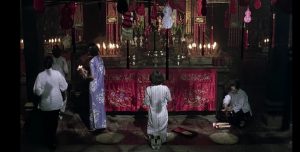
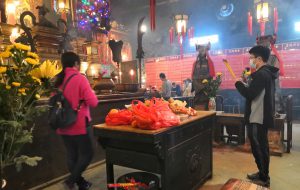
Left: Fleur pray for fortune in Man Mo Temple. Scenes from the Golden Harvest’s Rouge 1988, directed by Stanley Kwan. Right: Secondary students and their parents praying for their academic.
Golden Harvest released Rouge in January 1988. The film adapts the homonymous novel by Lilian Li and tells a tragic love story between Fleur (Anita Mui), a popular courtesan and Chan Chen-Pang (Leslie Cheung), a play boy from a wealthy family. The story is narrated through two timelines. First, it opens with them falling in love in the brothel in 1934. Due to the disapproval by Chan’s parents, they decide to commit suicide desperately and meet afterlife. Their story is gradually unfolded with flashback by Fleur, a disgruntled ghost searching for their lost lover in1987 with the aid of Yuen (Alex Man) and his girlfriend Ah Chor (Emily Chu). The story takes place in Hong Kong yet some scenes are taken in Macau.
Man Mo Temple and Tank Lane in Sheung Wan are featured in the film. In Rouge, Fleur has a habit of drawing fortune sticks at Man Mo Temple for her career every first and fifteenth of the Lunar Calendar. Man Mo Temple witness their relationship from falling in love to their despair to death. In reality, the place carries the earnest hope of many students in Hong Kong. When I visited the Temple, there were a lot of secondary students praying for blessings for their coming public exam. Furthermore, Tank Lane, where Fleur glides noiselessly behind Yen along from his office, remains the same with the stall still standing on the side. Getting lost in this fast-changing metropolitan, she hopes to find a shelter to stay. The panning of camera through their confrontation conveys the place with a sense of mystery, building up the tension on Fleur’s identity. Yet, Tank Lane, in reality, is just a common staircase in the Central District.


Fleur following Yuen along Tank Lane. Scenes from the Golden Harvest’s Rouge 1988, directed by Stanley Kwan.
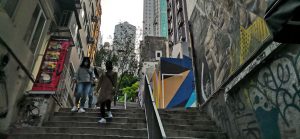
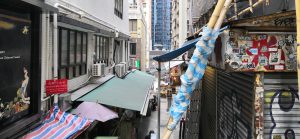
Tank Lane nowadays.
Shek Tong Tsui, Central and Western District, Hong Kong
Shek Tong Tsui was once Hong Kong’s red-light district where the brothel in the story is located in the 1930s and later replaced by a kindergarten in 1987. The place has experienced huge changes in 50 years while all are washed away by urbanization after several decades. When Fleur is walking up Hill Road, the place is both familiar and unfamiliar to her. In the movie, Waiting for Chan’s arrival at this “old spot”, she is disappointed by him breaking his promise. The place is captured in the late evening as Fleur’s activity is restricted only to the nighttime. For this reason, it is presented in a doomy and gloomy atmosphere in the film. In reality, the place becomes a popular spot for restaurants and cafes filled with youthful and lively vibe as it is surrounded by university and secondary schools after the opening of MTR station.

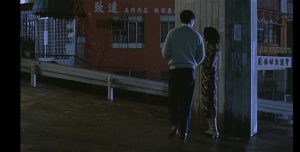
Fleur and Yuen walking up Hill Road. Scenes from the Golden Harvest’s Rouge 1988, directed by Stanley Kwan.
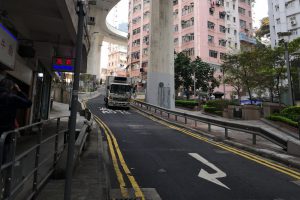
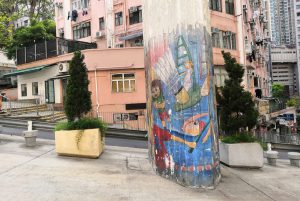
Hill Road nowadays.
Overall, the film has greatly emphasized the vast changes in the city which is no longer what is used to be and so is their relationship. Rouge also depicts Fleur and Yuen of different times hold different views towards love, Fleur with a vigorous love and latter with a modest but cherished one, serving as a contrast to the former’s romantic tragedy. In my opinion, despite the disappearance of buildings or relationships, appearance happens and things emerge in new form inevitably. What we can do is to cherish every moment in life.
— Wong Lok Yu Angel 3035794375
Good effort in locating and matching the locations of Man Mo Temple, Tane Lane and Hill Road. Enjoy your observation of the students who go to the temple to pray for good results. But rather than simply pointing out the difference, perhaps the attention should be directed to how the main hall where Fleur prays is depicted and framed in the film including attention on the color schema (darker and less saturated in the film?), and the space as you have observed during your field work. Did you observe what were included in the film frames and what were not compared to the actual spaces? Which of these three spaces appear in both timelines and how do they compare to each other and to the contemporary in 2021? When you write that the panning of the camera of the two lead characters on Tank Lane during the night scene conveys “the place with a sense of mystery,” explain how you see this to work. Is it the cropped frames, lighting, the emptiness and night silence…? Did you stay on into the night on Tank Lane and Hill Road to search for evidences of what still exists and what no longer does? The film stills you have captured here also show close-ups of the characters and the site. What kinds of visual, perceptual and emotional effects, if any, are produced when those same sites that you visit are presented much more cropped and close ups in the film?
Finally, what do the drawings on the highway columns tell you about Hill Road and the neighborhood between 1988 and 2021? It would be useful to consider some of the fieldwork discoveries made of the spaces of the temple, the street and under the highway through de Certeau’s spatial analysis of everyday spaces and Augé’s discussion on non-places. In this case, I would argue that in the film, the seemingly non-descript non-space under the highway on Hill Road in the 1980s becomes a place of meeting and encounter. Fast forward to 2021 and with some research on that same space, you will discover that in reality, far from being a non-place, the space is an urban public park, a rest space for workers during the work week, and a site for temporary religious festivals, etc.